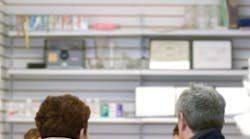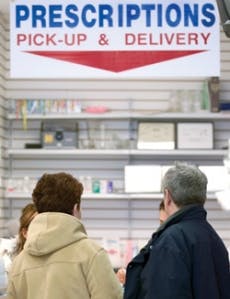Thomas A. Viola, RPh, CCP
The patient said to our pharmacy technician, “Yes, that’s it! What else is there to say? Don’t you think I know what medications I’m taking?” During a busy day at the pharmacy, I rely heavily on my selective hearing skills, trying to drown out the mundane in an effort to concentrate, while at the same time trying to tune in to situations that require my attention. In this case, no such tuning in skill was required, as this patient spoke loud enough to ensure that every employee in every pharmacy within three miles would never ask him that question again.
The gentleman at the counter was a new patient, and our pharmacy technician was attempting to obtain his medical history and current medications. Since this gentleman was a new patient, we had to start from scratch and obtain all his information, much to his chagrin.
In my alter ego, as instructor of pharmacology and professional speaker, I have consistently extolled the virtues of obtaining a complete medical history. It is an art, learned through trial and error, and a wonder to behold when performed by an experienced artist. It requires walking a fine line between practitioner and interrogator, obtaining the information without alienating the patient. Even after 25 years, I’m still an apprentice, learning my craft. I walked up to this patient, introduced myself, and briefly explained our need for his medical information.
With the canvas ready, it was time for the paint. I asked this patient, “So, what do you take?” and nothing more. He looked at me and asked, “What do you mean?” I avoided eye contact and refused to give him any other clues. If he wanted further interaction he would have to start talking. After a few seconds of awkward silence, he said, “I already told the young lady, it’s right there on the paper. What else is there to say?”
If you’re wondering why I didn’t further qualify the question, consider this. If I had followed with, “Do you take any other medications?” you know what two-letter answer I would have received. Open-ended questions were the way to go. If I had followed with, “What other medications do you take?” I’m sure he would have mentioned anything he takes from a prescription bottle. I’m also sure he would have omitted any over-the-counter products, herbal products, and dietary supplements he was taking, since I asked him for medications. I had to dig deep with this patient. He was being evasive and I had to get him talking.
How did I know he was being evasive? Consider the drug he did mention. Digoxin is used primarily for the treatment of congestive heart failure. Congestive heart failure is not ordinarily a primary diagnosis, but rather secondary to other conditions such as high blood pressure, coronary artery disease, heart valve disorders, chronic alcohol abuse, and more. Was this patient truly one of the few that had no other comorbid conditions? If not, what other medications was he taking and why was he refusing to admit to them?
If you’re wondering why I didn’t just ask, “What other medical conditions do you have?” consider this. Years of obtaining medical histories have taught me that patients will more likely admit to the medications they take rather than admit to the conditions the medications treat.
I have often referred to the value of a strong knowledge of pharmacology as an ally, a gentle inner voice that whispers in my ear and guides me in making decisions about patient care and treatment modifications. I knew that if I could get this patient to admit to the medications he was taking, I could use my knowledge of pharmacology to fill in the blanks. (By the way, so could you!) I knew from just the one drug that there was more to this story than I was getting, and I needed it all. I asked this gentleman to accompany me to a more private area and he reluctantly agreed.
In this less public setting, the new patient opened up. He was living on a limited income and doing all he could to make ends meet. His health plan offered no prescription coverage and he did not yet qualify for Medicare. Digoxin was the only drug he could afford to get at a pharmacy because it is relatively inexpensive. What about the other medications and supplements he was taking?
There were 10 items in all. He purchased some over the counter at discount stores and some over the Internet. Others he received from family members overseas. The rest he obtained from his neighbors or peers at prescription drug “swap meets,” which I imagine are slowly supplanting Bingo as evening entertainment for the over-60 crowd. In my mind, I could see him brokering the deal: “I’ll trade you six Nexium for four Lipitor.” One can only imagine what that little blue, diamond-shaped tablet is worth in trade!
I was concerned about this patient. He was flying under the radar, taking medications without the advice of his health-care team, medications of questionable origin and efficacy. The Internet was his physician, and his neighbors were his pharmacists. I knew enough about counterfeit drugs to be concerned about his safety. I immediately identified a few interactions among the drugs he was taking. Many of them had dental considerations and would impact his dental therapy.
This patient admitted to all of this slowly and reluctantly, afraid that I might report him to the “prescription police.” Indeed, that is exactly why he chose our small pharmacy over a chain pharmacy location. It took time and patience to gain his trust. If he was fearful of admitting this information to me, what would he admit to his physician, dentist, or dental hygienist?
That day, I made more than a few phone calls to enroll this man in patient assistance programs and prescription discount programs to ensure he was taking medications of high quality that he could afford. I also referred him to our local physician and dental offices for treatment and follow-up. Now when this new patient, and friend, comes in to our pharmacy, we exchange mutual appreciation and respect with a smile and hearty handshake and, often, without a word.
After all, what else is there to say?
Thomas A. Viola, RPh, CCP, is a practicing pharmacist and pharmacy consultant as well as a professional speaker and writer. He is a member of the dental hygiene faculty at Harcum College, Manor College, Middlesex County College, Burlington County College, and Bergen Community College. Tom offers CE presentations on dental pharmacology and local anesthesia to dental professionals nationally. To contact him for speaking engagements, call (609) 504-9252 or email [email protected] his website at www.thomasviola.com, and find him on Facebook at www.facebook.com/dentalpharmacology and www.facebook.com/dentallocalanesthesia.
Past RDH Issues







